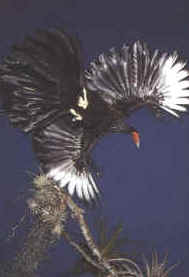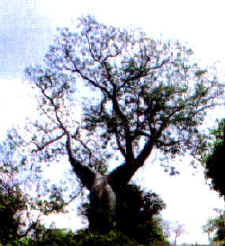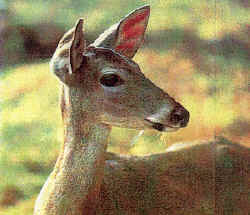MARCAVELICA - COTO DE CAZA "EL ANGOLO"
|
|
|
|
|
PAVA SALVAJE |
HUALTACO |
VENADO |
COTO DE CAZA “EL ANGOLO”En
el Perú existen dos cotos de caza considerados como reservas
nacionales: El Angolo y Suchubamba. El Angolo tiene una extensión de
65,000 hás y se ubica entre Marcavelica y Tumbes, aproximadamente a 100
kms. del puente Samán, como punto de referencia, donde se inicia un
camino conocido para llegar al “Angolo”. Esta
unidad forma parte de los bosques secos del noroeste que se extienden
desde América Central hasta el noroeste del Perú. La temperatura media
anual es de 17ºC y la precipitación varía entre 250 a 500 mm.;
precipitaciones en forma de lluvia o neblina. La elevación varía desde
200 hasta 1613 m.s.n.m. El
relieve corresponde a colinas y cerros de la cadena de los Amotapes
separados por quebradas inundables. Las fuentes de agua son
estacionarias quedando reducidas a pozos de agua aisladas durante la época
seca. Esta
zona ecológica se caracteriza por albergar en su seno especies como el
venado de cola blanca, puma, sajino, ardilla nuca blanca, zorro
sechurano, venado rojo, oso hormiguero, gato silvestre. Aves
como el cóndor, el buitre real, gavilán, cernícalos, perdices,
palomas de diversos tipos y una gran variedad de aves cantoras propias
de la zona. Existen reptiles como el colambo, macanche, iguanas y otros.
La
especie vegetal que más predomina es el algarrobo, habiendo también,
el angolo, el charán, el faique, el palo santo, el almendro, el
polopolo, el portillo, el ceibo, la tara, el sapote, el hualtaco, el
huasango, la salvajina y diversas cetáceas. Cabe
destacar que e El Angolo, con sus paisajes tan bellos y naturales, fauna
y flora representativa de los bosques secos, es parte de la reserva
mundial de la Biosfera del Noroeste, reconocida por la UNESCO en 1977 En
la actualidad el coto de caza de “El Angolo”, que está administrado
por el grupo Romero, viene siendo reforestado y poblando de animales
destinados a la caza con especies procedentes de otros lugares, por
ejemplo, la pava salvaje de Estados Unidos. También se ha
reacondicionado el albergue. La zona es ideal para realizar camping y
turismo de aventura. |
LIMIT OF IT HUNTS “THE ANGOLO” In the Peru two hunt limits considered as national reservations exist: The Angolo and Suchubamba. The Angolo has an extension of 65,000 hás and it is located among Marcavelica and Knock down, approximately to 100 kms. of the bridge Samán, as reference point, where a well-known road begins to arrive to the “Angolo.” This unit is part of the dry forests of the northwest that extend from Central America until the northwest of the Peru. The annual half temperature is of 17ºC and the precipitation varies among 250 to 500 mm.; precipitations in rain form or fog. The elevation varies from 200 up to 1613 m.s.n.m. The relief corresponds to hills and hills of the chain of the Amotapes separated by gulches possible of flood. The sources of water are stationary being reduced to wells of water isolated during the time without rains. This ecological area is characterized to harbor in its breast species like the deer of white line, puma, sajino, squirrel white nape, fox sechurano, red deer, I dare anthill, wild cat. Ave like the condor, the real vulture, sparrow hawk, kestrels, partridges, doves of diverse types and a great variety of birds singers characteristic of the area. Reptiles exist as the colambo, macanche, iguanas and others. The vegetable species that more prevails is the locust, there being also, the angolo, the charán, the faique, the sacred stick, the almond tree, the polopolo, the porotillo, the ceibo, the hangup, the sapote, the hualtaco, the huasango, the salvajina and diverse cetáceas. Cabe to highlight that and The Angolo, with its landscapes so beautiful and natural, fauna and representative flora of the dry forests, is part of the world reservation of the Biosphere of the Northwest, recognized by the UNESCO in 1977 At the present time the hunt limit of “The Angolo”, it is administered by the group Romero, and it is reforested and populating of animals dedicated to the hunt with species coming from other places, for example, the wild pava of United States. The housing has also been reconditioned. The area is ideal to carry out camping site and adventure tourism. |
BEGRENZUNG DAVON JAGT “DER ANGOLO” Im Peru existieren zwei Jagd-Begrenzungen, die als nationale Bedenken betrachtet werden,: Der Angolo und Suchubamba. Der Angolo hat eine Vergrößerung von 65,000 hás und es wird unter Marcavelica gefunden und klopft hinunter, ungefähr zu 100 kms. von der Brücke Samán, als Hinweis-Punkt, wo eine bekannte Straße anfängt, zu anzukommen, das “Angolo.” Diese Einheit ist Teil von den trockenen Wäldern vom Nordwest, bis der sich von Mittelamerika ausstrecken, das nordwestlich vom Peru. Die jährliche Hälfte Temperatur ist von 17ºC und dem Niederschlag, variiert unter 250 bis 500 mm.; Niederschläge in Regen-Form oder Nebel. Das Hochheben variiert von 200 bis zu 1613 m.s.n.m. Die Erleichterung entspricht Hügeln und Hügeln von der Kette vom Amotapes, die von Bergschluchten möglich von Flut getrennt werden. Die Quellen von Wasser sind werdend zu Brunnen von Wasser reduziert haltend, sonderte während der Zeit ohne Regen ab. Dieses ökologische Gebiet wird zu Hafen in seiner Brust-Spezies wie charakterisiert der Hirsch von weißer Linie, Puma, sajino, Eichhörnchen weißer Nacken, Fuchs-sechurano, Rotwild, den ich Ameisenhaufen, wilde Katze, wage. Ave mag den Kondor, der wirkliche Geier, Sperling-Falke, kestrels, Rebhühner, Tauben von verschiedenartigen Arten und einer großen Vielfalt von Vögel-Sängern charakteristisch vom Gebiet. Reptilien existieren als der colambo, macanche, Leguane und andere. Die pflanzliche Spezies daß mehr vorherrscht, ist die Heuschrecke und es gibt auch, der angolo, der charán, der faique, der heilige Stock, der Mandel-Baum, der polopolo, der porotillo, der ceibo, der Komplex, der sapote, der hualtaco, der huasango, der salvajina und verschiedenartiger cetáceas. Cabe hervorzuheben, daß und Der Angolo, mit seinen Landschaften so schön und natürlich, Fauna und repräsentative Flora der trockenen Wälder, ist Teil vom Welt-Bedenken von der Biosphäre des Nordwest, der vom UNESCO in 1977 erkannt wird, Bei der Gegenwart timen Sie die Jagd-Begrenzung von “Der Angolo”, es wird von der Gruppe Romero verwaltet, und es wird wieder aufgeforstet, und das Besiedeln von Tieren weihte zur Jagd mit Spezies, die von anderen Stellen kommt, zum Beispiel der wilde pava Vereinigter Staaten. Die Unterbringung ist auch überholt worden. Das Gebiet ist ideal, zeltende Stelle und Abenteuer-Tourismus auszuführen. |


